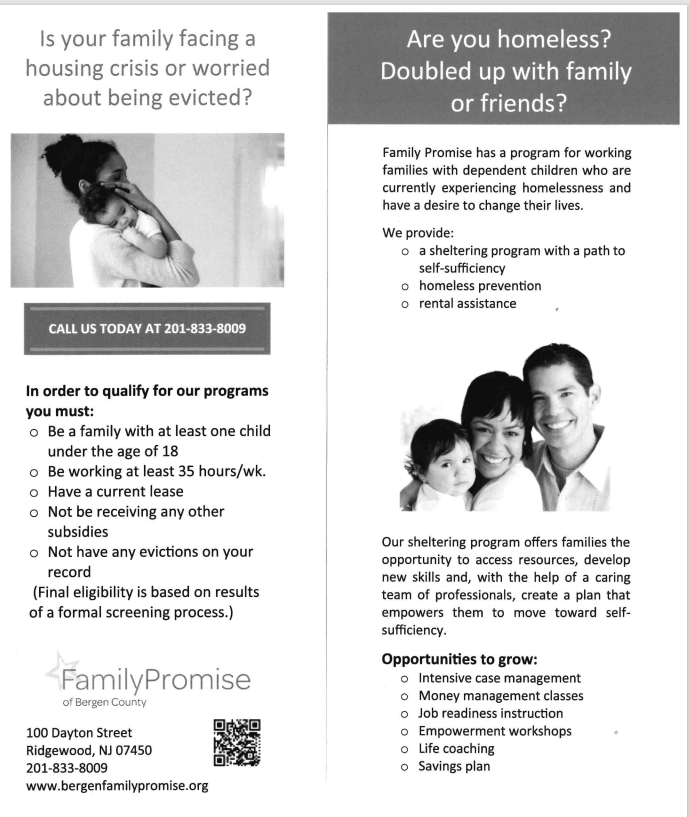-
McKinney-Vento (Student Homelessness)
Contact Information
McKinney-Vento Liaison
Mrs. Stephanie Kropp
email: skropp@shmemorial.org
phone: 201-440-2782 ext 140
Low-income residents in Bergen County, NJ, can find resources through the Bergen County Board of Social Services, which can connect them to various programs including food assistance (NJ SNAP), cash assistance (Work First New Jersey), and housing assistance (Housing Authority of Bergen County). Other helpful services include free tax preparation (VITA/TCE), emergency homeless prevention assistance, and programs for home energy and repairs. A great starting point for locating and screening for benefits is the state's NJHelps portal.
For food pantries, try: https://www.findhelp.org/search/text?term=bergen+county&postal=07055&language=en
To start your search:
- NJHelps: Use the online portal to screen for benefits you may qualify for, including food, cash, and housing assistance.
- 211: Dial 211 to connect with a local resource specialist who can provide information on health and human services in New Jersey.
Food and nutrition:
- NJ SNAP: Apply for the Supplemental Nutrition Assistance Program to get help buying groceries.
- Center for Food Action: Provides emergency food assistance and can help with security deposits and first-month's rent to prevent homelessness.
Cash assistance:
- Work First New Jersey: Visit the NJ.gov website for information on temporary cash assistance for families and individuals.
Housing:
- Housing Authority of Bergen County (HABC): Provides housing opportunities and rental assistance, including a large Section 8 program. They also have programs for homeless prevention, which can help with security deposits and rental arrears.
- Greater Bergen Community Action, Inc. (GBCA): Offers affordable housing and home energy assistance programs.
- Bergen County Department of Administration and Finance: Provides a home improvement program for eligible residents.
Other resources:
- Bergen County Social Services: Contact the Bergen County Board of Social Services for assistance with various needs.
- VITA/TCE: Find free tax preparation services through the IRS's Volunteer Income Tax Assistance and Tax Counseling for the Elderly programs.
- Bergen Family Center: Offers a variety of services to help families strengthen their independence.
- Bergen HEARTS: Helps families in a homeless emergency find a safe living environment.
- West Bergen Mental Healthcare: Provides therapeutic treatments for individuals and families, as listed on the Bergen County, NJ – Official Website.
Online Resources
Parent/Unaccompanied Youth Information
New Jersey Department of Education | McKinney-Vento
Education of Homeless School Policy 5116
National Center of Homeless Education
What is McKinney Vento?
¿Qué es La Ley McKinney-Vento?
http://www.youtube.com/watch?v=c2vr8gJiAGo
Education for Homeless Children, Youth, and Students in State Facilities, and Educational Stability for Children

What is the purpose of the McKinney-Vento Education for Homeless Children and Youth (McKinney-Vento) program?
The McKinney-Vento program is designed to address the problems that homeless children and youth have faced in enrolling, attending, and succeeding in school. Under this program, State educational agencies ensure that each homeless child and youth has equal access to the same free, appropriate public education, including a public preschool education, as other children and youth.
What is meant by the term "homeless children and youth"?
The McKinney-Vento Act defines "homeless children and youth" as individuals who lack a fixed, regular, and adequate nighttime residence. The term includes:
• children and youth who are: sharing the housing of other persons due to loss of housing, economic hardship, or a similar reason (sometimes referred to as doubled-up);
• living in motels, hotels, trailer parks, or camping grounds due to lack of alternative adequate accommodations;
• living in emergency or transitional shelters; abandoned in hospitals; or awaiting foster care placement;
• children and youth who have a primary nighttime residence that is a public or private place not designed for, or ordinarily used as, a regular sleeping accommodation for human beings;
• children and youth who are living in cars, parks, public spaces, abandoned buildings, substandard housing, bus or train stations, or similar settings; and
• migratory children who qualify as homeless because they are living in circumstances described above.

